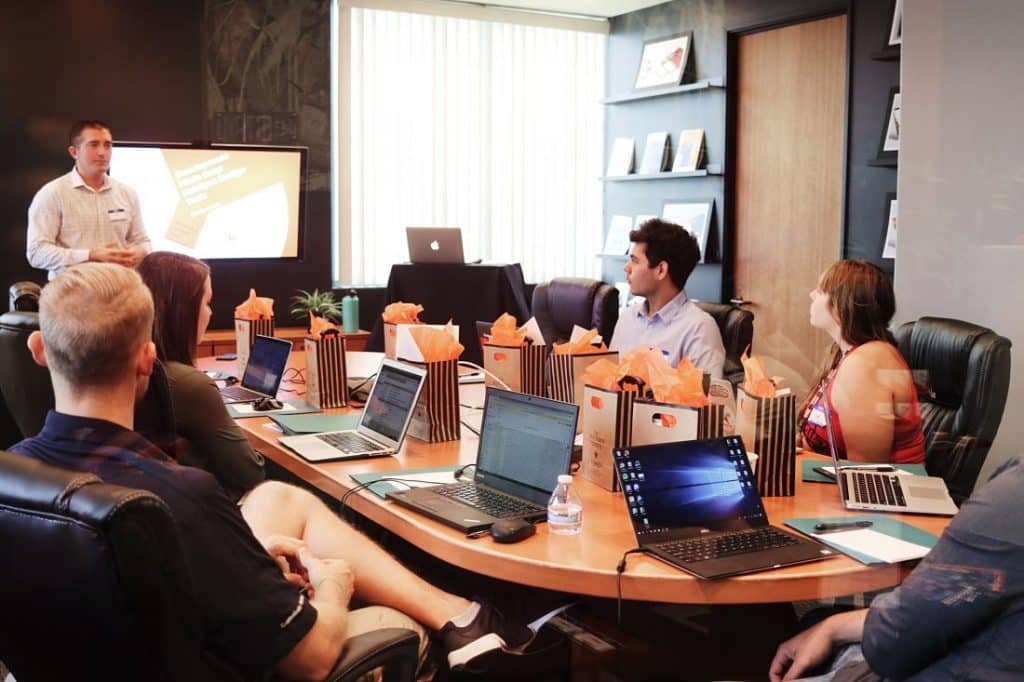E-learning consists of learning through digital resources. In this modality, students use computers, mobiles and tablets in order to learn, and nowadays it is inevitably linked to the Internet. There are several e-learning modalities, either in fully online training or through blended learning.
What are the main e-learning modalities?
Blended learning, Flipped Classroom, Mobile learning o Microlearning son some of the main modalities for e-learning study. These modalities are evolving over time to adapt to the changing needs and contexts of education.
# 1 Blended learning
Blended learning is one of the e-learning modalities. It combines online training with face-to-face training. The blended learning model has been gaining ground in recent years and is one of the main ways that schools have to bet on e‑learning. Traditional teaching models are obsolete and today, students expect learning that contains more interaction and collaboration, in addition to the use of technology as a means of learning.

This e-learning modality increases school performance, since students are more likely to do well if teachers use different tools. In this way, they have several options to learn a new concept. Also, thanks to the segmentation and analysis that e‑learning allows, it is more difficult for students to fail, because tutors can see in which materials the student is doing poorly. Thanks to this type of monitoring, students can avoid losing interest in the course.
This can be especially important for those students with special needs, since it keeps them in the classroom and reinforces outside of class what they have seen in the lesson, by using a variety of interesting content that helps them maintain their interest and effort.
# 2 Flipped classroom
In a flipped classroom, the e-learning part takes place outside the educational center. Students study the content individually at home through online software and use the time in the classroom to put it into practice. In this way, class time is more productive, since it is used to deepen the contents, clarify doubts and encourage collaborative work.
Since students begin on a different basis, each of them may need a different time to acquire the same knowledge. In traditional teaching, all students have to follow the same rhythm in the classroom, but, in the inverted classroom, students can spend as much time as they want on each lesson. Therefore, each student can rely on their progress to spend more or less time on each lesson and thus ensure that they have understood everything correctly.
Many companies and educational centers have established this model among all e-learning modalities for their classes. The flipped classroom offers great flexibility when it comes to forming groups, which is very convenient for schools. This type of model puts an end to corseted schedules and contributes to the permanence of students in their studies.
# 3 Mobile learning
Another of the e-learning modalities is mobile learning or m-learning. It consists of the use of mobile applications to access e-learning resources. The multi-device apps allow that students study where and when they decide. In this way, the rhythm adapts to the needs and possibilities of each student. Also, thanks to the possibility of pre-downloading the content, students can access the contents of the e-learning courses even without an Internet connection.
While a topic is being studied, numerous questions may arise. It is likely that students forget their questions if they do not solve them soon, which translates into a learning deficit. Mobile learning facilitates immediate communication between students and teachers, even live when online tutorials are established. Students feel more confident about being able to send a message at any time from the course itself and, therefore, they ask more questions.
The teacher can answer the questions directly or can gather the students’ questions to solve them in a group lesson, either virtual or face-to-face. In this way, students will be solving their doubts while learning from the approaches and difficulties of others, which is part of social learning.
# 4 Microlearning
Microlearning is an e-learning modality characterized by short lessons or knowledge pills by modules. Microlearning allows adapting and personalizing learning. In this e-learning modality, content curation is very relevant, since its most remarkable virtue is the speed with which it is consumed, that is, the brevity of the lessons.
One of the great advantages of microlearning is that educational pills can be updated and modified very easily, which maintains or even increases their impact. In addition, since the exercises focus on very specific concepts, it is easier to label the lessons and make searches faster.
Video also usually plays a leading role in this e-learning modality. Every teacher will probably be familiar with the Dale Learning Cone (1969), which establishes the probability we have of retaining what we learn depending on how we do it. According to Dale, watching a video we retain 50% versus the 10% we retain reading.
For e-learning to be a success, there is no doubt that it is necessary to rely on a sector leader like CAE, with more than 40 years of experience in the e-learning sector and advising large training projects day after day.
You may also like:

